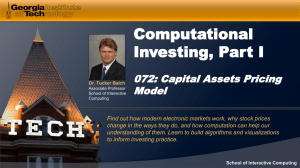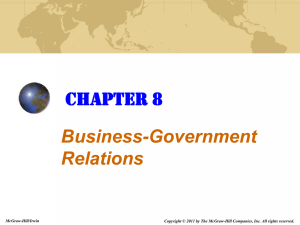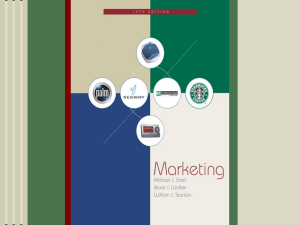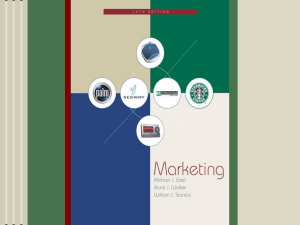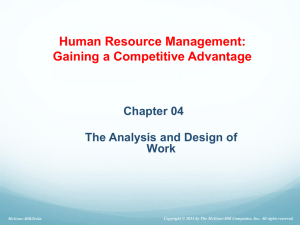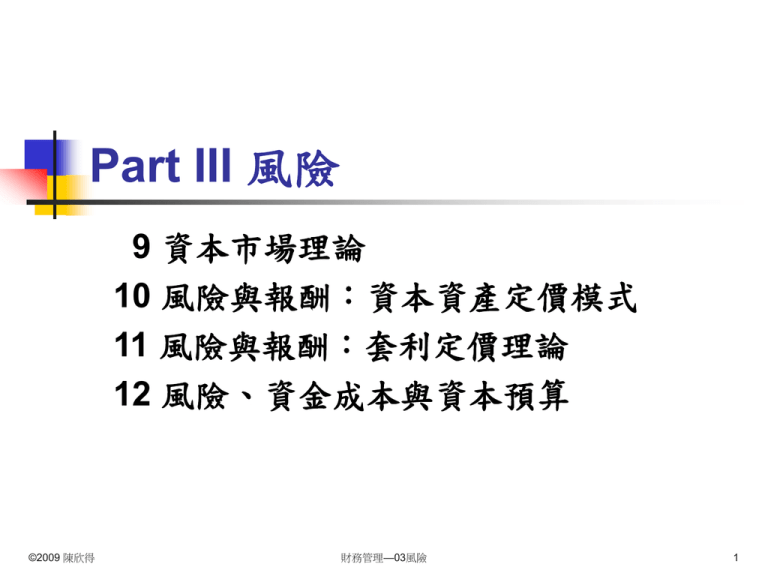
Part III 風險
9 資本市場理論
10 風險與報酬:資本資產定價模式
11 風險與報酬:套利定價理論
12 風險、資金成本與資本預算
©2009 陳欣得
財務管理—03風險
1
第九章
資本市場理論
9.1
報酬
9.2
持有期間的報酬
9.3
報酬率的統計數字
9.4
平均報酬與無風險報酬
第十章
風險與報酬:資本資產定價模式
10.1
報酬的期望值、變異數與共變數
10.2
兩資產組合的效率前緣
10.3
多項資產組合的風險
10.4
無風險借貸
10.5
決定資產風險
10.6
報酬與風險的關係
©2009 陳欣得
財務管理—03風險
2
第十一章
風險與報酬:套利定價理論
第十二章
風險、資金成本與資本預算
12.1
權益成本
12.2
估計 Beta 值
12.3
影響 Beta 值的因素
12.4
基本權益成本估計模型之延伸
12.5
降低資金成本
©2009 陳欣得
財務管理—03風險
3
第九章 資本市場理論
©2009 陳欣得
9.1
9.2
9.3
9.4
報酬
持有期間的報酬
報酬率的統計數字
平均報酬與無風險報酬
財務管理—03風險
4
9.1
報酬
報酬(return)
:分成股利收益與資本所得兩項。
Dividends
Ending
market value
Time
0
1
Initial
investment
報酬 股利收益 資本利得
percentage return dividend yield capital gains yield
©2009 陳欣得
財務管理—03風險
5
【例題】Suppose you bought 100 shares of Wal-Mart (WMT) one year ago today at
$25. Over the last year, you received $20 in dividends (= 20 cents per share ×
100 shares). At the end of the year, the stock sells for $30. How did you do?
【解】
投資金額: $25 100 $2,500
股利收益:$20,
報酬率
資本利得: $30 100 $2,500 $500
$20 $500
20.8%
$2,500
另一種算法:
報酬率 股利報酬率 資本利得報酬率
©2009 陳欣得
$0.20 $30 $25
0.8% 20% 20.8%
$25
$25
財務管理—03風險
6
9.2
持有期間的報酬
holding period return (1 r1 ) (1 r2 )
其中, r1 , r2 ,
©2009 陳欣得
(1 rn ) 1
, rn 是持有期間各期的報酬率
財務管理—03風險
7
【例題】四年的報酬率如下:
Year Return
1
10%
2
-5%
3
20%
4
15%
請計算平均年報酬率。
【解】
總報酬 (1 r1 ) (1 r2 ) (1 r3 ) (1 r4 ) 1
(1.10) (.95) (1.20) (1.15) 1
0.4421 44.21%
平均一年的報酬(幾何平均)
(1 rg ) 4 (1 r1 ) (1 r2 ) (1 r3 ) (1 r4 )
rg 4 (1.10) (.95) (1.20) (1.15) 1 0.095844 9.58%
請注意,直接拿各年報酬率作算數平均得到的數值為:
r r r r 10% 5% 20% 15%
(算數)平均報酬 1 2 3 4
10%
4
4
©2009 陳欣得
財務管理—03風險
8
持有期間報酬的實證結果:
1000
10
Common Stocks
Long T-Bonds
T-Bills
0.1
1930
©2009 陳欣得
1940
1950
1960
1970
財務管理—03風險
1980
1990
2000
9
9.3
報酬率的統計數字
Series
Average
Annual Return
Standard
Deviation
Large Company Stocks
12.2%
20.5%
Small Company Stocks
16.9
33.2
Long-Term Corporate Bonds
6.2
8.7
Long-Term Government Bonds
5.8
9.4
U.S. Treasury Bills
3.8
3.2
Inflation
3.1
4.4
– 90%
Distribution
0%
+ 90%
Source: © Stocks, Bonds, Bills, and Inflation 2003 Yearbook™, Ibbotson Associates, Inc., Chicago (annually updates work by
Roger G. Ibbotson and Rex A. Sinquefield). All rights reserved.
©2009 陳欣得
財務管理—03風險
10
9.4
平均報酬與無風險報酬
風險溢酬(Risk Premium)
:因承擔風險所多出來的報酬。
無風險報酬(Risk-Free Return)
:無需承擔風險的報酬。
風險的定義
風險(Risk)
:報酬的標準差(報酬的變動大小)
。
©2009 陳欣得
財務管理—03風險
11
風險與報酬的取捨
18%
Small-Company Stocks
Annual Return Average
16%
14%
Large-Company Stocks
12%
10%
8%
6%
T-Bonds
4%
T-Bills
2%
0%
5%
10%
15%
20%
25%
30%
35%
Annual Return Standard Deviation
60
40
20
0
-20
Common Stocks
Long T-Bonds
T-Bills
-40
-60 26
30
35
40
45
50
55
60
65
70
75
80
85
90
95 2000
Source: © Stocks, Bonds, Bills, and Inflation 2000 Yearbook™, Ibbotson Associates, Inc., Chicago (annually updates work by
Roger G. Ibbotson and Rex A. Sinquefield). All rights reserved.
©2009 陳欣得
財務管理—03風險
12
【例題】四種資產的報酬率分別為: 5% 、 5% 、10% 、18% ,請計算其報酬率之標
準差(風險)
。
【解】
報酬之平均為: r
標準差: sr
©2009 陳欣得
r1 r2 r3 r4 5% 5% 10% 18%
7%
4
4
r1 r 2 r2 r 2 r3 r
4 1
財務管理—03風險
2
r4 r
2
9.63%
13
有關標準差的計算:
r r rn r
r 1 2
n
n
r1 r
sr
2
rn r
r2 r
2
2
r1 r 2 r2 r 2
r12
rn r
n 1
r22
2
rn2
n r r
2
2
2
r
n
r 2 r n
2
n 1
如例題 3 的計算:
r
-5
5
10
18
28
2
r
25
25
100
324
474
n 4, r 28, r 2 474
r 28
r
7
n
4
sr
©2009 陳欣得
r 2 r
財務管理—03風險
n 1
2
282
474
n
4 278 9.63
4 1
3
14
第十章 風險與報酬:資本資產定價模式
©2009 陳欣得
10.1
10.2
10.3
10.4
10.5
10.6
報酬的期望值、變異數與共變數
兩資產組合的效率前緣
多項資產組合的風險
無風險借貸
決定資產風險
報酬與風險的關係
財務管理—03風險
15
10.1
報酬的期望值、變異數與共變數
Rate of Return
Scenario Probability Stock fund Bond fund
Recession
33.3%
-7%
17%
Normal
33.3%
12%
7%
Boom
33.3%
28%
-3%
狀態
衰退
持平
景氣
機率(f)
1/3
1/3
1/3
報酬率
股票(X)
債券(Y)
-7%
17%
12%
7%
28%
-3%
股票平均報酬 X X 11%
Xf
-0.0233
0.0400
0.0933
0.1100
ΣX
Yf
0.0567
0.0233
-0.0100
0.0700
ΣY
2
Xf
0.0016
0.0048
0.0261
0.0326
2
ΣX
2
Yf
0.0096
0.0016
0.0003
0.0116
2
ΣY
XYf
-0.0040
0.0028
-0.0028
-0.0040
ΣXY
債券平均報酬 Y Y 7%
股票報酬變異數 sX2 X 2 X 0.0326 0.112 0.0205
2
債券報酬變異數 sY2 Y 2 Y 0.0116 0.072 0.0067
2
s X X 2 X 14.3%
sY Y 2 Y 8.2%
2
2
股票與債券共變異數 sX ,Y XY X Y 0.0040 0.11 0.07 0.0117
股票與債券相關係數
©2009 陳欣得
s X ,Y
s X sY
0.0117
0.9950
0.1430 0.0820
財務管理—03風險
16
股票與債券各佔 50%的投資組合:
Scenario
Recession
Normal
Boom
Expected return
Variance
Standard Deviation
©2009 陳欣得
Rate of Return
Stock fund Bond fund Portfolio
-7%
17%
5.0%
12%
7%
9.5%
28%
-3%
12.5%
11.00%
0.0205
14.31%
7.00%
0.0067
8.16%
財務管理—03風險
squared deviation
0.160%
0.003%
0.123%
9.0%
0.0010
3.08%
17
©2009 陳欣得
兩資產組合的效率前緣
% in stocks
Risk
Return
0%
5%
10%
15%
20%
25%
30%
35%
40%
45%
50%
55%
60%
65%
70%
75%
80%
85%
90%
95%
100%
8.2%
7.0%
5.9%
4.8%
3.7%
2.6%
1.4%
0.4%
0.9%
2.0%
3.1%
4.2%
5.3%
6.4%
7.6%
8.7%
9.8%
10.9%
12.1%
13.2%
14.3%
7.0%
7.2%
7.4%
7.6%
7.8%
8.0%
8.2%
8.4%
8.6%
8.8%
9.0%
9.2%
9.4%
9.6%
9.8%
10.0%
10.2%
10.4%
10.6%
10.8%
11.0%
Portfolio Return
10.2
Portfolo Risk and Return Combinations
12.0%
11.0%
10.0%
9.0%
8.0%
7.0%
6.0%
5.0%
0.0% 2.0% 4.0% 6.0% 8.0% 10.0% 12.0% 14.0% 16.0%
Portfolio Risk (standard deviation)
財務管理—03風險
18
return
各種情況之兩資產組合:
100%
stocks
= -1.0
100%
bonds
= 1.0
= 0.2
©2009 陳欣得
財務管理—03風險
19
10.3
項資產組合的風險
Diversifiable Risk;
Nonsystematic Risk;
Firm Specific Risk;
Unique Risk
Portfolio risk
Nondiversifiable risk;
Systematic Risk;
Market Risk
n
兩類風險:
(1)可藉由投資組合分散的風險:可分散風險、非系統風險、廠商特有風險。
(2)無法藉由投資組合分散的風險:不可分散風險、系統風險、市場風險。
©2009 陳欣得
財務管理—03風險
20
return
效率前緣(efficient frontier)
c
effi
ier
t
n
t fro
ien
minimum
variance
portfolio
Individual
Assets
P
©2009 陳欣得
財務管理—03風險
21
10.4
無風險借貸
return
各種組合與政府公債間的借貸方式
L
CM
efficient frontier
rf
P
跨期借貸觀念
©2009 陳欣得
財務管理—03風險
22
資本市場線(Capital Market Line, CML)
return
(風險 與報酬 r 為一直線關係。)
L
CM
100%
stocks
Optimal
Risky
Portfolio
rf
100%
bonds
©2009 陳欣得
財務管理—03風險
23
分離性質(The Separation Property)
分離性質(separation property)
:資本市場線(CML)的存在隱含以下性質
(1)所有人有共同的 CML 與最適投資組合(M 點)
(2)風險取向不同的投資者,會選擇在相同 CML 上的不同位置
©2009 陳欣得
財務管理—03風險
24
return
不同無風險資產決定不同資本市場線
1
f
0
f
r
r
C
L 0 CML 1
M
100%
stocks
First
Optimal
Risky
Portfolio
Second Optimal
Risky Portfolio
100%
bonds
(下一階段:整合各種不同風險的資本市場線。)
©2009 陳欣得
財務管理—03風險
25
10.5
決定資產風險
以市場最適投資組合為基礎來衡量個別資產的風險。
個別資產風險的測量值:
i
Cov( Ri , RM )
2 ( RM )
其中, RM 為市場最適投資組合的報酬率
©2009 陳欣得
財務管理—03風險
26
Security Returns
以迴歸線決定 值
ne
i
L
c
i
ist
r
cte
a
ar
h
C
Slope = i
Return on
market %
Ri = i + iRm + ei
(個別資產之報酬 ri 與市場報酬 rM 間的關係。)
©2009 陳欣得
財務管理—03風險
27
10.6
報酬與風險的關係
市場的期望報酬:
RM RF Market Risk Premium
市場的期望報酬 無風險報酬 市場風險溢酬
個別資產的期望報酬:
R i RF βi ( R M RF )
市場風險溢酬
©2009 陳欣得
財務管理—03風險
28
Expected return
資本資產定價模式(Capital Asset Pricing Model, CAPM)
:
R i RF β i ( R M RF )
RM
RF
1.0
©2009 陳欣得
財務管理—03風險
29
【例題】市場投資組合報酬為 10%,無風險報酬為 3%,某資產的 1.5,請以 CAPM
計算該資產的期望報酬。
【解】
Ri 3% 1.5 (10% 3%) 13.5%
©2009 陳欣得
財務管理—03風險
30
第十一章 風險與報酬:套利定價理論
©2009 陳欣得
財務管理—03風險
31
Slide 32
Arbitrage Pricing Theory
Arbitrage arises if an investor can
construct a zero investment portfolio
with a sure profit.
– Since no investment is required, an
investor can create large positions to
secure large levels of profit.
– In efficient markets, profitable arbitrage
opportunities will quickly disappear.
McGraw-Hill/Irwin
Copyright © 2008 by The McGraw-Hill Companies, Inc. All rights reserved
套利定價理論(Arbitrage Pricing Theory)
若投資者可以建構一個零投入、有確定收益的投資組合,
則稱為存在套利機會。
若有套利機會,則該投資者可以創造極大的收益。
在效率市場,套利機會很快就會消失。
©2009 陳欣得
財務管理—03風險
33
Slide 34
11.1 Factor Models: Announcements,
Surprises, and Expected Returns
• The return on any security consists of two
parts.
– First, the expected returns
– Second, the unexpected or risky returns
• A way to write the return on a stock in the
coming month is:
R R U
where
R is the expected part of the return
U is the unexpected part of the return
McGraw-Hill/Irwin
Copyright © 2008 by The McGraw-Hill Companies, Inc. All rights reserved
因素模型(Factor Models)
投資的報酬分為兩部分:可預期報酬與不可預期報酬。
R R U
©2009 陳欣得
財務管理—03風險
35
Slide 36
Risk: Systematic and
Unsystematic
We can break down the total risk of holding a stock into
two components: systematic risk and unsystematic risk:
2
R R U
becomes
Total risk
R Rmε
Nonsystematic Risk:
Systematic Risk: m
where
m is 系統風險
ε is 非系統風險
n
McGraw-Hill/Irwin
Copyright © 2008 by The McGraw-Hill Companies, Inc. All rights reserved
Slide 37
Systematic Risk and Betas
• For example, suppose we have identified
three systematic risks: inflation, GNP
growth, and the dollar-euro spot exchange
rate, S($,€).
• Our model is:
R Rmε
R R βI FI βGNP FGNP βS FS ε
βI is the inflation beta(通貨膨脹)
βGNP is the GNP beta
βS is the spot exchange rate beta(匯兌)
ε is the unsystematic risk
McGraw-Hill/Irwin
Copyright © 2008 by The McGraw-Hill Companies, Inc. All rights reserved
Systematic Risk and Betas:
Example
Slide 38
R R βI FI βGNP FGNP βS FS ε
• Suppose we have made the following estimates:
1. I = -2.30
2. GNP = 1.50
3. S = 0.50
• Finally, the firm was able to attract a “superstar”
CEO, and this unanticipated development
contributes 1% to the return.
ε 1%
R R 2.30 FI 1.50 FGNP 0.50 FS 1%
McGraw-Hill/Irwin
Copyright © 2008 by The McGraw-Hill Companies, Inc. All rights reserved
Systematic Risk and Betas:
Example
Slide 39
R R 2.30 FI 1.50 FGNP 0.50 FS 1%
We must decide what surprises took place in the
systematic factors.
If it were the case that the inflation rate was
expected to be 3%, but in fact was 8% during
the time period, then:
FI = Surprise in the inflation rate = actual –
expected
= 8% – 3% = 5%
R R 2.30 5% 1.50 FGNP 0.50 FS 1%
McGraw-Hill/Irwin
Copyright © 2008 by The McGraw-Hill Companies, Inc. All rights reserved
Systematic Risk and Betas:
Example
Slide 40
R R 2.30 5% 1.50 FGNP 0.50 FS 1%
If it were the case that the rate of GNP
growth was expected to be 4%, but in
fact was 1%, then:
FGNP = Surprise in the rate of GNP growth
= actual – expected = 1% – 4% = –
3%
R R 2.30 5% 1.50 (3%) 0.50 FS 1%
McGraw-Hill/Irwin
Copyright © 2008 by The McGraw-Hill Companies, Inc. All rights reserved
Systematic Risk and Betas:
Example
Slide 41
R R 2.30 5% 1.50 (3%) 0.50 FS 1%
If it were the case that the dollar-euro spot
exchange rate, S($,€), was expected to
increase by 10%, but in fact remained
stable during the time period, then:
FS = Surprise in the exchange rate
= actual – expected = 0% – 10% = –
10%
R R 2.30 5% 1.50 (3%) 0.50 (10%) 1%
McGraw-Hill/Irwin
Copyright © 2008 by The McGraw-Hill Companies, Inc. All rights reserved
Systematic Risk and Betas:
Example
Slide 42
R R 2.30 5% 1.50 (3%) 0.50 (10%) 1%
Finally, if it were the case that the
expected return on the stock was 8%,
then:
R 8%
R 8% 2.30 5% 1.50 (3%) 0.50 (10%) 1%
R 12%
McGraw-Hill/Irwin
Copyright © 2008 by The McGraw-Hill Companies, Inc. All rights reserved
Slide 43
11.6 CAMP 與 APT
• APT applies to well diversified portfolios and
not necessarily to individual stocks.
• With APT it is possible for some individual
stocks to be mispriced - not lie on the SML.
• APT is more general in that it gets to an
expected return and beta relationship without
the assumption of the market portfolio.
• APT can be extended to multifactor models.
McGraw-Hill/Irwin
Copyright © 2008 by The McGraw-Hill Companies, Inc. All rights reserved
Slide 44
11.7 Empirical Approaches to Asset
Pricing
• Both the CAPM and APT are risk-based models.
• Empirical methods are based less on theory and
more on looking for some regularities in the
historical record.
• Be aware that correlation does not imply
causality.
• Related to empirical methods is the practice of
classifying portfolios by style, e.g.,
– Value portfolio
– Growth portfolio
McGraw-Hill/Irwin
Copyright © 2008 by The McGraw-Hill Companies, Inc. All rights reserved
第十二章 風險、資金成本與資本預算
©2009 陳欣得
12.1
12.2
12.3
12.4
12.5
權益成本
估計Beta值
影響Beta值的因素
基本權益成本估計模型之延伸
降低資金成本
財務管理—03風險
45
12.1
權益成本
公司剩餘資金的投資報酬率應高於股東個人的投資報酬率。
Firm with
excess cash
Pay cash dividend
Shareholder
invests in
financial
asset
A firm with excess cash can either pay a
dividend or make a capital investment
Invest in project
Shareholder’s
Terminal
Value
資本資產定價模式(CAPM)是一個估計權益成本方法:
Ri RF βi ( RM RF )
其中需先知道: RF 為無風險報酬率、 RM RF 為市場的風險溢酬、公司的 i 值。
©2009 陳欣得
財務管理—03風險
46
【例題】Suppose the stock of Stansfield Enterprises, a publisher of PowerPoint
presentations, has a beta of 2.5. The firm is 100-percent equity financed.
Assume a risk-free rate of 5-percent and a market risk premium of 10-percent.
What is the appropriate discount rate for an expansion of this firm?
【解】
已知: i 2.5 、 RF 5% 、 RM RF 10% ,
Ri RF βi (RM RF ) 5% 2.5 10% 30%
©2009 陳欣得
財務管理—03風險
47
IRR
Project
利用證券市場線(SML)評估專案的優劣:
SML
Good
A
project
30%
B
5%
C
Bad project
Firm’s risk (beta)
2.5
©2009 陳欣得
財務管理—03風險
48
12.2
估計 Beta 值
Beta 的公式:
βi
Cov( Ri , RM ) σ i , M
2
Var ( RM )
σM
會影響 Beta 估計值的因素:
(1)時間、(2)樣本大小、(3)融資與風險狀況。
使用產業 Beta 值或個別公司 Beta 值?
若公司與產業平均狀況同質,用產業 Beta 值。
雖然一個公司的 Beta 值很穩定,但是不同投資專案應該有不同 Beta 值。
©2009 陳欣得
財務管理—03風險
49
【例題】某 g 公司與其產業在過去四年的報酬資料如下,請計算 g 公司的 Beta 值。
年度
1
2
3
4
Rg
-10%
3%
20%
15%
RM
-40%
-30%
10%
20%
【解】
計算草稿與過程如下:
年度
1
2
3
4
合計
Rg
-10%
3%
20%
15%
0.2800
ΣRg
0.30 0.40 4
RM
-40%
-30%
10%
20%
-0.4000
ΣRM
2
RM
0.1600
0.0900
0.0100
0.0400
0.3000
ΣRM2
2
M2
βg
©2009 陳欣得
4 1
Cov( Rg , RM )
Var ( RM )
σ g ,M
σ M2
0.0867
g ,M
Rg×RM
0.0400
-0.0090
0.0200
0.0300
0.0810
Σ(Rg×RM)
0.081 0.28 0.40 4
4 1
0.0363
0.0363
0.42
0.0867
財務管理—03風險
50
12.3
影響 Beta 值的因素
討論三個影響 Beta 值的因素:
經營風險:
(1)收益週期循環性(Cyclicity of Revenues)
(2)營運槓稈(Operating Leverage)
財務風險:
(3)財務槓桿(Financial Leverage)
收益週期循環性(Cyclicity of Revenues)
一般高循環性的股票有較高的報酬。
高循環性並不意味著高變異性。
©2009 陳欣得
財務管理—03風險
51
營運槓稈(Operating Leverage)
:衡量固定成本對營收得影響。
固定成本增加會增加營運槓桿,反之,變動成本增加則減少營運槓桿。
營運槓桿會擴大收益的循環變動。
衡量營運槓桿(Degree of Operating Leverage,DOL)
:
EBIT
DOL EBIT
Sales
Sales
$
EBIT
Total
costs
Fixed costs
Volume
Fixed costs
Volume
©2009 陳欣得
財務管理—03風險
52
財務槓桿(Financial Leverage)
:衡量固定資金成本對營收得影響。
Asset
Debt
Equity
Debt
Equity
Debt Equity
Debt Equity
負債
權益
負債
權益
資產 負債 權益
負債 權益
©2009 陳欣得
財務管理—03風險
53
【例題】某全部權益的 g 公司之 Beta 值為 0.8。若該公司將財務槓桿調整為 1 比 2
(1 份負債比 2 份權益)
,則該公司權益的 Beta 值為何?(假設負債的 Beta 值
為零)
【解】
負債 0
狀況一,全部權益:
資產
負債
負債 權益
負債
權益
1
權益 權益 0.8
負債 權益
1
資產 權益 0.8
狀況二,資產 Beta 值不變下,負債權益比調整為 1: 2 :
資產
負債
負債 權益
權益
©2009 陳欣得
負債
權益
負債 權益
權益
2
權益 0.8
1 2
3
3
資產 0.8 1.2
2
2
財務管理—03風險
54
12.4
基本權益成本估計模型之延伸
公司風險與專案風險
專案的資金成本與該資金的用途(use)有關,而與該資金的來源(source)無關。
Project IRR
因此,資金成本應以專案的風險為評估依據,而不是以公司的風險為依據。
The SML can tell us why:
Incorrectly accepted
negative NPV projects
RF βFIRM ( R M RF )
Hurdle
rate
rf
FIRM
©2009 陳欣得
SML
Incorrectly rejected
positive NPV projects
Firm’s risk (beta)
財務管理—03風險
55
加權平均資金成本(Weighted Average Cost of Capital,WACC)
rWACC
S
B
rS
rB 1 TC
BS
BS
其中: S 權益總金額、 rS 權益報酬率、B 負債總金額、 rB 負債利息、 TC 公司稅
率
©2009 陳欣得
rS RF RM RF
財務管理—03風險
56
【例題】某公司負債的市值為 4000 萬,權益的市值為 6000 萬。該公司給付負債 15%
的利息,且該公司的 Beta 值等於 1.41,適用稅率為 34%。若無風險利率為 11%,
市場的風險溢酬為 9.5%,請計算該公司的加權平均資金成本。
【解】
基本資料: B 4000 、 S 6000 、 rB 15% 、 1.41 、 TC 34% 、 RF 11%
rS RF RM RF 11% 1.41 9.5% 24.40%
rWACC
©2009 陳欣得
6000
4000
24.40%
15% 1 0.34 18.60%
4000 6000
4000 6000
財務管理—03風險
57
12.5
降低資金成本
流動性(Liquidity)
:資產、有價證券的變現能力。
變現能力有兩個層面:(1)變現時間、(2)變現成本。
Cost of Capital
流動性與資金成本的關係:
Liquidity
©2009 陳欣得
財務管理—03風險
58
請就下列資料回答 5、6、7 三題:
弘海公司有閒餘資金新台幣 1 億元,將分散投資於高科技產業(30%)與傳統產
業(70%)
。投資時預期之景氣狀態與報酬率資料如下表:
景氣狀態
蕭條
一般
繁榮
發生機率
0.2
0.5
0.3
高科技預期報酬
-3%
10%
18%
傳統產業預期報酬
4%
6%
8%
5. 該公司預期之投資組合報酬為何?
6. 該公司之投資組合之風險為何?
7. 若想要讓投資組合風險最低,則投資於高科技產業的權重(比例)應為何?
【解】
景氣狀態
蕭條
一般
繁榮
發生機率
0.2
0.5
0.3
投資組合報酬
1.90%
7.20%
11.00%
E X 7.28%
Xf
0.0038
0.0360
0.0330
0.0728
X2f
0.000072
0.002592
0.003630
0.006294
E X 2 E X 0.006294 0.07282 3.15%
2
©2009 陳欣得
財務管理—03風險
59
8. A 公司的平均報酬率為 20%,標準差 8%;市場的平均報酬率為 12%,標準差 6%。
若 A 公司與市場報酬率的相關係數為 0.8,請計算 A 公司的 beta 值。
【解】
B 8%, M 6%, B,M 0.8
A
©2009 陳欣得
AM AM A 0.8 8%
1.07
M
6%
M2
財務管理—03風險
60
請就下列資料回答 9、10、11 三題:
假設 B 公司之β值為 1.5,市場投資組合之平均報酬率為 12%,無風險利率為 4%,且
稅率為 30%。此公司之資本結構為負債與業主權益分別占 40%與 60%,其中負債的利
率為 9%。
9. 該公司的權益成本( rS )為為何?
10. 該公司的實質(稅後)負債成本為何?
11. 該公司的加權資金成本( rWACC )為為何?
【解】
rS rf rM rf 4% 1.5 12% 4% 16%
rB 1 TC 9% 1 30% 6.3%
rWACC
©2009 陳欣得
S
B
60
40
rS
rB 1 TC
16%
6.3% 12.12%
BS
BS
100
100
財務管理—03風險
61
結束
©2009 陳欣得
Part III
財務管理—03風險
62



